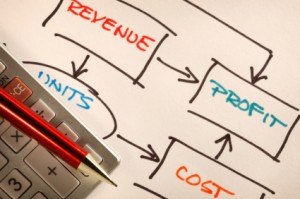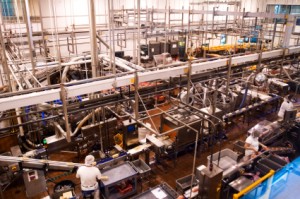The Cost of Poor Costing
by Andy Bigalow, CPIM
The goal of any complex manufacturing business is to make profits. But the inability to calculate your true manufacturing costs could lead to lost profits, orders, and customers. To remain competitive, you need to know the answers to a number of questions: Are you able to price your products at profitable levels? Are you producing these products at the right factory? Are you contributing to overhead and profit levels enough to meet strategic business goals?
How often have you said to your colleagues, “If we had better costing, we would get profitable business, know where to make this product, and meet our divisional or corporate profit objectives.” Probably never! More likely you may have said “If we had better pricing, we would get more profitable business?” Well let’s start with understanding what a profitable business is by answering the question, “What is profit”?
Profit = Price – Cost
OK, Simple enough. You know what you quoted is our selling price. And your ERP system tells you a cost based on the materials, labor and overhead used to make the widget. So you have everything you need, right? Not so fast. How confident are you that your ERP is giving you the true costs accrued during the manufacturing process?
Your company likely invested lots of money, time and resources in an ERP system to take orders, buy materials, build and ship products, produce invoices, collect money and in the end, produce a financial statement showing the results of the business operations. All of these processes are transactional in nature, and ERP systems are fantastic at tracking transactions.
Many ERP systems also include the ability to cost products. But for complex manufacturing companies, calculating costs is not transactional in nature. There are a number of factors that influence the true cost of manufacturing products than just material, labor and overhead.
How can you know what your profit is when you don’t know your true costs?
Your competitor just undercut your price, so to be competitive in the market you’re probably thinking that all you have to do is meet or beat your competitor’s price to get the deal. Let’s just reduce or eliminate the overhead contribution, and quote the price based on the materials and labor then mark up the cost to meet the company profit margins. Right? Wrong. There are many manufacturing companies who price on the basis of what their competitors charge or the market price, without considering whether their competitors have a different cost structure or knowing their own true manufacturing costs. If you base your prices on what others are doing, you’ll never know if you’re taking in profitable business.
Let’s take a different track that will bring in profitable business while remaining competitive by looking at an Enterprise Costing System (ECS). An enterprise-wide approach to costing allows you to break costs into greater detail than just materials, labor and overhead. Each Cost Object, or item that has a unique cost, is assigned an unlimited number of cost elements to describe the factors that make up the cost. In robust costing processes, multiple Cost Objects exist for a single product based on where it is built, how it is built, what raw materials were used to build it and what activities were required to produce it. Cost Objects should directly reflect how we make our products, not how our ERP system says we make our products. In conjunction with Cost Objects, enterprise cost systems have tools to build the logic needed to calculate costs in a manner that reflects your production processes.
 Effective enterprise cost systems should account for products made in multiple factories or manufacturing lines, changing raw material costs, and varied labor and overhead allocation rates. It should include the different depreciation rates by machine/department/factory, by production volumes, by product mix, by overhead absorption rates, by mold or tool allocation rates, by set-up times or even by overtime rates. By including this level of detail, you could know the product cost by factory or manufacturing line, contribution levels by overhead category (depreciation, utilities, benefits, molds, forms, etc.), and contribution levels based on product mix, volumes by time period and raw material price fluctuations.
Effective enterprise cost systems should account for products made in multiple factories or manufacturing lines, changing raw material costs, and varied labor and overhead allocation rates. It should include the different depreciation rates by machine/department/factory, by production volumes, by product mix, by overhead absorption rates, by mold or tool allocation rates, by set-up times or even by overtime rates. By including this level of detail, you could know the product cost by factory or manufacturing line, contribution levels by overhead category (depreciation, utilities, benefits, molds, forms, etc.), and contribution levels based on product mix, volumes by time period and raw material price fluctuations.
Think of it this way, Bill, Bob and you go out to eat. You order a hamburger for $5. Bill orders a steak sandwich for $10 and Bob orders a fillet minion steak dinner for $21. The total bill is $36 which Bob wants to split evenly 3 ways. It is the same way with your manufacturing processes. One of your processes requires additional resources (a component of overhead) such as new machines which require a higher depreciation rate, more floor space and higher energy costs. The enterprise system will allow you to allocate a different set of overhead costs to truly reflect the true cost of manufacturing this item and not burden the other items with the additional costs which they don’t occur.
Now you can price your products knowing if you’ll meet or beat our competitors’ pricing and still achieve your divisional or corporate profit margin requirements. You can look at overhead contribution for the time period that the product is produced and make informed decisions as to how much overhead burden is needed to contribute to meet corporate goals. This will allow you to win the business while still contributing to the overall financial gain of the company.
 Enterprise Costing Systems Do More than Just Calculate Costs
Enterprise Costing Systems Do More than Just Calculate Costs
Beyond calculating product costs, you can analyze inventory and raw material costs and compare actual and future costs of raw material commodities cost to the standard product cost stored in the ERP system. Now your pricing decisions are linked to the actual manufacturing cost which gives you a true competitive advantage in the market.
By taking an enterprise approach to product costing, you’ll have the detailed information to make capital expenditures decisions, work with accurate operational budgeting and make informed make vs. buy decisions for any or all of our manufacturing processes. Now you can decide the best plant to produce your products, which production lines to set idle, and which orders and price points to accept, giving you a competitive advantage over other manufacturers that don’t share the same level of cost insight. Without this insight you might end up taking unprofitable orders, filling your factory with the wrong business.
By knowing the true costs of producing products at all of your factories, enterprise costing gives you the knowledge needed to make strategic and operational decisions that will keep our business profitable.
Remember – The cost of poor costing can cost you.